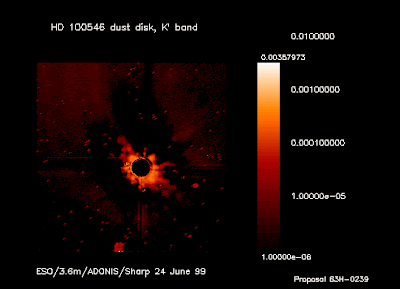Καλλιτεχνική
απεικόνιση του γίγαντα αερίου που σχηματίζεται σε απόσταση 335 ετών φωτός. This
artists impression shows the formation of a gas giant planet in the ring of
dust around the young star HD 100546. This system is also suspected to contain
another large planet orbiting closer to the star. The newly-discovered object
lies about 70 times further from its star than the Earth does from the Sun.
This protoplanet is surrounded by a thick cloud of material so that, seen from
this position, its star almost invisible and red in color because of the
scattering of light from the dust. Credit:
ESO/L. Calçada
Ομάδα
αστρονόμων εντόπισε και κατέγραψε εικόνες από τη γέννηση ενός πλανήτη.
Χρησιμοποιώντας το τηλεσκόπιο VLT του Νότιου Ευρωπαϊκού Παρατηρητηρίου (ESO) οι
ερευνητές παρατήρησαν το νεαρό άστρο HD 100546 που βρίσκεται σε απόσταση 335
ετών φωτός από εμάς. Στο δίσκο της κοσμικής ύλης που έχει δημιουργηθεί γύρω από
το άστρο έχουν ξεκινήσει οι διεργασίες δημιουργίας ενός ηλιακού συστήματος. Οι
ερευνητές υποστηρίζουν ότι εντόπισαν έναν πλανήτη που βρίσκεται στα αρχικά
στάδια του σχηματισμού του.
H
ανακάλυψη
The planet
candidate around HD 100546 was detected as a faint blob located in the
circumstellar disc revealed thanks to the NACO adaptive optics instrument on
ESO’s VLT, combined with pioneering data analysis techniques. The observations
were made using a special coronagraph in NACO, which operates at near-infrared
wavelengths and suppresses the brilliant light coming from the star at the
location of the protoplanet candidate.
«Μέχρι
σήμερα οι επιστήμονες μπορούσαν να μελετήσουν τη διαδικασία σχηματισμού ενός πλανήτη κυρίως
μέσα από προσομοιώσεις. Αν πράγματι αυτό που είδαμε και καταγράψαμε είναι ο
σχηματισμός ενός πλανήτη τότε για πρώτη φορά οι επιστήμονες θα μπορούν
μελετήσουν το φαινόμενο σε πραγματικές συνθήκες και μάλιστα από τα πρώτα, τα
αρχικά του στάδια» αναφέρει ο Σάσα Κουάνζ, του Πανεπιστημίου ETH στη Ζυρίχη που
ήταν μέλος της ερευνητικής ομάδας.
Aριστερά
μια εικόνα του κοσμικού δίσκου που έχει δημιουργηθεί στο άστρο HD 100546 μέσα
στον οποίο σχηματίζεται ένας γίγαντας αερίου. Δεξιά η εικόνα του πλανήτη όπως
την κατέγραψαν οι ερευνητές με το τηλεσκόπιο VLT. VLT and Hubble images of the
protoplanet system HD 100546.
Οι
ερευνητές εκτιμούν πώς, όταν ολοκληρωθεί ο σχηματισμός του πλανήτη, αυτός θα
είναι ένας γίγαντας αερίου τρεις φορές μεγαλύτερος από τον Δία. Η έρευνα
δημοσιεύεται στην επιθεώρηση «Astrophysical Journal Letters».
This video
fly-through show the dusty environment around the star HD 100546. A gas giant
planet appears to be forming in the ring of dust around the young star. This
system is also thought to probably contain another large planet orbiting closer
to the star. The protoplanet candidate lies about 70 times further from its
star than the Earth does from the Sun and the inner planet lies about ten times
closer in. Credit: ESO/L.
Calçada




Δεν υπάρχουν σχόλια:
Δημοσίευση σχολίου